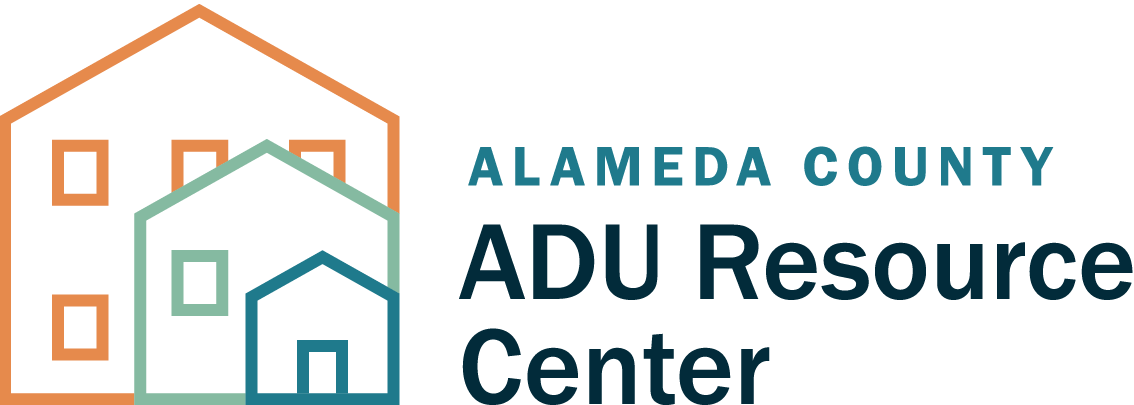Alameda County ADU Glossary
Make sure you understand all the important terms about ADUs and the process.
PLANNING AND ZONING TERMS
ASSESSOR’S PARCEL NUMBER (APN) A unique number assigned to every site or lot in CA.
BUILDING CODE State-established rules ensuring buildings are built safely, including plumbing, electrical, etc. Cities often amend State code.
DEED RESTRICTIONS Conditions or rules that are added to a deed for a house.
LOT COVERAGE The area of a property that can have buildings on it in relation to total lot area, usually expressed as a percentage. Zoning code specifies lot coverage for your lot.
LOT SIZE total square footage of your property. MIXED-USE ZONING allows multiple uses on a property, such as commercial on the first floor of a building and residential above.
OWNER OCCUPANCY A requirement that homeowners live on the property (this currently applies to JADUs and not ADUs).
SETBACKS The minimum distance a building can be from front, side, or back property lines. A 4’ side setback means any building must be at least 4’ from the property side.
SINGLE-FAMILY / MULTIFAMILY Single-family zoning means one home on a property. Multifamily zoning means more than one home (e.g., apartments).
ZONING/ZONING CODE Local rules about what can be built on a site, including how tall buildings can be, where they can be on a lot, etc. All lots are assigned a zone, and each zone has different regulations.
DESIGN DEFINITIONS
ARCHITECT A design professional licensed by the state. Architects are trained in design and construction management.
CONCEPTUAL DRAWINGS/SCHEMATICS Initial drawings of your site and proposed structure, including floorplan and other structures and outside features (e.g., trees).
CONSTRUCTION DRAWINGS Detailed drawings including architectural and mechanical systems, with details needed for construction.
DESIGN/BUILD COMPANY Designs your ADU, manages the process, and builds it. Most often run by a licensed contractor who has designers or architects and builders on staff.
DESIGNER A professional who either has architectural training but is not licensed, is self-taught, or falls somewhere in between. DRAFTER Someone who does architectural drawings.
ELEVATION DRAWING A drawing that shows a straight-on view, usually of an exterior wall. INSPECTIONS A visit from trained professionals to ensure your structure is being built according to your permit application. REFINED DRAWINGS Refined drawings of your site and proposed structure, including doors, windows, fixtures, and other detailed features.
SURVEY A professional examination/drawing of your property, including boundaries. This is not always required for ADUs but may be the only way to officially confirm your property boundaries.
PERMITS
BUILDING PERMIT Officially states that your project meets code and construction can start.
PLAN CHECK Multiple departments reviewing your plans for compliance and flagging issues. PLANNING PERMIT Officially states your project meets zoning, land use, and planning rules.
PUBLIC HEARINGS A public meeting where elected officials and the public can comment on a proposed project; uncommon for ADUs.
FEES
BUILDING PERMIT FEES cover the costs of processing and inspections. These fees can vary and are often a few thousand dollars.
DEED RESTRICTION FILING FEES cover County recording of your deed restriction.
HARD COSTS The direct costs of construction.
IMPACT FEES support area infrastructure and services. Often the largest fees for ADUs, but cannot be charged for ADUs under 750 SF.
PLANNING PERMIT FEES cover Planning Department review of your project.
SCHOOL DISTRICT FEES support local schools through a per square foot development fee. Cannot be charged for ADUs under 500 SF.
SOFT COSTS Non-construction costs: design services, permitting fees, and others.
UTILITY FEES vary by the size and location of your ADU. Existing buildings do not require water fees and fees for new buildings must be in proportion to the size of the ADU.
Download the Guidebook to learn more and to download a for a printable version of the Glossary

